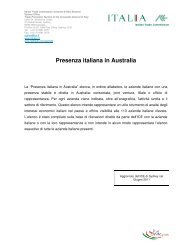Price Determination in the Australian Food Industry A Report
Price Determination in the Australian Food Industry A Report
Price Determination in the Australian Food Industry A Report
You also want an ePaper? Increase the reach of your titles
YUMPU automatically turns print PDFs into web optimized ePapers that Google loves.
GRAIN AND OILSEED PRODUCTS<br />
Analysis of <strong>the</strong> determ<strong>in</strong>ants of prices and costs <strong>in</strong> product value cha<strong>in</strong>s<br />
GRAINS AND FLOUR – OVERVIEW<br />
Background<br />
The wheat <strong>in</strong>dustry is predom<strong>in</strong>antly (85 per cent) export focused, while <strong>the</strong> flour <strong>in</strong>dustry is <strong>the</strong><br />
reverse, with only 10 per cent of production exported.<br />
The wheat <strong>in</strong>dustry has undergone significant change from a highly regulated <strong>in</strong>dustry to one that<br />
is now deregulated on <strong>the</strong> domestic market but still has export regulation via a s<strong>in</strong>gle desk.<br />
Management of this s<strong>in</strong>gle desk is undertaken under <strong>the</strong> supervision of a statutory authority.<br />
While <strong>the</strong> domestic market and <strong>the</strong> storage, handl<strong>in</strong>g and transport arrangements are now fully<br />
deregulated, <strong>the</strong> history of regulation still has some <strong>in</strong>fluence on <strong>the</strong> market and pric<strong>in</strong>g.<br />
The flour <strong>in</strong>dustry has undergone considerable rationalisation. Today <strong>the</strong>re are 10 mill<strong>in</strong>g<br />
companies, although only four of <strong>the</strong>se are <strong>in</strong>volved <strong>in</strong> <strong>the</strong> retail packet flour market. The <strong>in</strong>dustry<br />
is highly competitive, low marg<strong>in</strong> and suffers from considerable under-utilisation (estimated to be<br />
30 per cent at present).<br />
The <strong>in</strong>dustry’s product mix and use<br />
The market mix of <strong>the</strong> <strong>in</strong>dustry <strong>in</strong> 2002 saw only 5 per cent of flour production used <strong>in</strong> <strong>the</strong> retail<br />
flour market. The graph gives a picture of <strong>the</strong> flour market.<br />
Packet flour is really only used <strong>in</strong> retail. Flour go<strong>in</strong>g to all non-retail areas is <strong>in</strong> 25kg bags or some<br />
o<strong>the</strong>r bulk form. The bread sector is dom<strong>in</strong>ant with 45 per cent of <strong>the</strong> usage. It should be noted<br />
that until <strong>the</strong> Goodman Fielder sale of mills only 18 per cent of this was unaligned – Westons own<br />
<strong>the</strong>ir own flour mills and bakeries as did Goodman Fielder. Effectively <strong>the</strong>re has been little change<br />
as Goodman contracts <strong>the</strong>ir flour requirements and controls <strong>the</strong> plant bakery.<br />
<strong>Price</strong> <strong>Determ<strong>in</strong>ation</strong> <strong>in</strong> <strong>the</strong> <strong>Australian</strong> <strong>Food</strong> <strong>Industry</strong> A <strong>Report</strong><br />
74<br />
The packet flour market is <strong>in</strong> decl<strong>in</strong>e. Pasta use has shown significant growth (note that this uses<br />
durum wheat and different mill<strong>in</strong>g technology and thus does not have a direct <strong>in</strong>fluence on <strong>the</strong><br />
companies <strong>in</strong>volved <strong>in</strong> packet flour).<br />
Export has also shown strong growth off a low base over <strong>the</strong> last couple of years but trade does<br />
tend to be opportunistic.<br />
Figure 77. Market mix of <strong>the</strong> <strong>in</strong>dustry’s use of flour, 2002<br />
<strong>in</strong>dustrial<br />
26%<br />
Source: <strong>Industry</strong> Sources<br />
export<br />
10%<br />
pasta<br />
5%<br />
Major drivers of pric<strong>in</strong>g<br />
o<strong>the</strong>r<br />
6% packet flour 5%<br />
biscuits<br />
5%<br />
pastry/cakes 4%<br />
bread 39%<br />
The ma<strong>in</strong> factor that affects prices through <strong>the</strong> cha<strong>in</strong> is <strong>the</strong> <strong>in</strong>ternational price of wheat. The wheat<br />
<strong>in</strong>put represents <strong>the</strong> major cost component and directly <strong>in</strong>fluences flour price. International prices<br />
are driven by supply and demand, climate and exchange rates. International wheat prices reflected<br />
<strong>in</strong> <strong>the</strong> <strong>Australian</strong> Wheat Board pool price effectively set <strong>the</strong> price at which millers purchase wheat.







